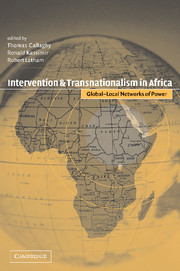Book contents
- Frontmatter
- Contents
- List of contributors
- Preface
- List of abbreviations
- 1 Introduction: transboundary formations, intervention, order, and authority
- Part I Historical dimensions and intellectual context
- Part II Theoretical frameworks
- Part III Transboundary networks, international institutions, states, and civil societies
- 6 Networks and governance in Africa: innovation in the debt regime
- 7 When networks blind: human rights and politics in Kenya
- 8 Global, state, and local intersections: power, authority, and conflict in the Niger Delta oil communities
- Part IV Political economies of violence and authority
- Part V Conclusion
- References
- Index
6 - Networks and governance in Africa: innovation in the debt regime
Published online by Cambridge University Press: 18 December 2009
- Frontmatter
- Contents
- List of contributors
- Preface
- List of abbreviations
- 1 Introduction: transboundary formations, intervention, order, and authority
- Part I Historical dimensions and intellectual context
- Part II Theoretical frameworks
- Part III Transboundary networks, international institutions, states, and civil societies
- 6 Networks and governance in Africa: innovation in the debt regime
- 7 When networks blind: human rights and politics in Kenya
- 8 Global, state, and local intersections: power, authority, and conflict in the Niger Delta oil communities
- Part IV Political economies of violence and authority
- Part V Conclusion
- References
- Index
Summary
Introduction
One of the most dramatic, systematic, and intrusive forms of external intervention in Africa over the past two decades has been “structural adjustment” – the efforts of the International Monetary Fund (IMF), the World Bank, and the major industrial states to get governments to reform their economies in significant ways. Structural adjustment is seen by powerful external actors as the way to reverse the decline and marginalization of African states as globalization accelerates. Most of these countries, however, have seen structural adjustment, with its high and detailed levels of conditionality, as a major threat to their sovereignty and politically dangerous; they have resisted it through the passive strategies of what I have called the ritual dances of reform (Callaghy and Ravenhill 1993). The result has been increasingly weak, sometimes failing, states.
One of the primary results of structural adjustment has been rising levels of external debt. It is mostly “official” debt owed to major Western countries, the International Monetary Fund, and the World Bank. Since the late 1950s, bilateral debt has been rescheduled by creditor countries organized into a mechanism that came to be known as the Paris Club, while multilateral debt could not be rescheduled. The Paris Club became the core of the international debt regime for official debt – that is the actors, norms, processes, and mechanisms focused around countries unable to service their bilateral debt.
- Type
- Chapter
- Information
- Intervention and Transnationalism in AfricaGlobal-Local Networks of Power, pp. 115 - 148Publisher: Cambridge University PressPrint publication year: 2001
- 17
- Cited by



